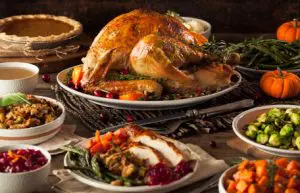Thanksgiving is a time to gather, not only with family, but also a time for fellowship in our churches. Safe food preparation is a goal of all good chefs and helpers whether preparing meals for home or for church. The holidays are a great time to review Food Safety Guidelines for Home and Church Kitchens.
whether preparing meals for home or for church. The holidays are a great time to review Food Safety Guidelines for Home and Church Kitchens.
The Centers for Disease Control and Prevention estimate that every year approximately 76 million people in the United States become ill from harmful bacteria in food. To minimize food risks, share a written policy/guidelines regarding food preparation/food safety with all employees and/or volunteers who work in your kitchen.
Food Safety for Church Kitchens -5 Steps to Food Safety
Preparation
- Only use foods before the “use by” date.
- Wash your hands with warm, soapy water for 20 seconds before and after handling food.
- Wash fruits and vegetables with cold water before using. There is no need to wash or rinse meat or poultry.
- Wash cutting boards, dishes, utensils, and counter tops with hot, soapy water before and in between using each food item.
- Use one cutting board for produce and a separate board for meat and poultry to reduce the risk of salmonella and other bacteria causing illnesses. Using different color cutting boards for different food items will help reduce cross contamination.
- Separate raw, cooked, and ready-to-eat foods while shopping, preparing, or storing. Never place cooked food on a plate that previously held raw meat, poultry, or seafood.
- Keep juices from different food items from mixing.
- Marinate meat, seafood, and poultry in the refrigerator in a covered, non-metallic container.
- To properly thaw frozen meat, it’s best to plan for slow, safe thawing in the refrigerator. Allow about one day for every five pounds of meat to thaw in the refrigerator.
- Looking at the color and texture of food is not enough – you have to use a food thermometer to be sure.
Temperature Safety
- USDA recommended safe minimum internal temperatures, measured with a food thermometer:
- Whole cut meat; beef, veal, lamb and pork – 145 degrees Fahrenheit (allow meat to rest for at least three minutes before carving or consuming).
- Ground meat; beef, veal, lamb and pork – 160 degrees Fahrenheit.
- All poultry (whole and ground) – 165 degrees Fahrenheit.
- Egg dishes – 160 degrees Fahrenheit
- Fish – 145 degrees Fahrenheit
- Ground beef – 160 degrees Fahrenheit
- Pork – 160 degrees Fahrenheit
- Poultry, whole and chicken breasts – 165 degrees Fahrenheit
- Steaks and roasts – 145 degrees Fahrenheit
- Do not serve home-canned foods-most outbreaks of food-borne botulism are caused by home-canned foods.
- Dispose of commercial canned foods that are leaking, bulging, swollen, look damaged or cracked, spurts liquid or foam when opened or is discolored, moldy or smells bad.
Serving
- Heated or refrigerate food until it is served.
- When hosting a buffet, do not mix new food with existing food.
- Use separate platters for holding raw and cooked food.
- Food should not be left out at room temperature for more than two hours (one hour if over 90 degrees Fahrenheit outside). Remember, many food brought from home will already have been out for a significant period of time.
- Refrigerate hot foods within two hours after cooking.
- Reheat leftovers to 165 degrees Fahrenheit or above. Reheat food only once.
- Keep hot foods at140 degrees Fahrenheit or above and cold foods at 40 degrees Fahrenheit or below. (Keep a log when and who checked temperatures.)
- Separate utensils for each food item during cooking and serving.
- Use disposable gloves when handling ready-to-eat foods without utensils.
Storage
- Label all foods with a date.
- Most refrigerated leftovers should be used in three to five days.
- Don’t ever taste food to check for freshness. When in doubt, throw it out.
- If using coolers, food should only be consumed if there is still ice in the cooler and the food is cooled to refrigerator temperature.
- Refrigerator temperatures should range from 34 to 40 degrees Fahrenheit (one to three degrees Celsius). Foods spoil rapidly above 40 degrees Fahrenheit (three degrees Celsius).
- The best temperature for frozen food storage is at zero degrees Fahrenheit (-17 degrees Celsius). The temperature should not reach higher than five degrees Fahrenheit (-15 degrees Celsius).
- Check refrigerator and freezer temperatures periodically and a log kept of when and who checked temperatures.
Kitchen Sanitation
- An agreement with a professional pest control service should be in place for the kitchen area. This is not a service that should be provided by inexperienced staff members or volunteers.
- Mechanical dishwashing equipment should be in good repair and temperature gauges should be monitored and documented.
- Garbage should be removed from the building after each meal.
- Garbage containers should be located an adequate distance away from the building.
- All food contact surfaces and utensils need to be cleaned and sanitized.
- Appropriate sanitizing solution should be used in correct concentrations. Bleach is not approved for sanitizing food contact surfaces.
- Employees and/or volunteers handling food should wash their hands frequently and correctly, should not use aprons or towels to dry hands after washing and should not handle, prepare or serve food if they have an apparent illness.
We would like to thank GuideOne Insurance for this information. https://www.guideone.com/safety-resources/food-safety-preparing-and-serving
Look for more tips to keep food safe at https://www.cdc.gov/foodsafety/
Stay up to date on food recalls at https://www.cdc.gov/foodsafety/outbreaks/
PRINTABLE GUIDES for WORKERS AND VOLUNTEERS
https://www.guideone.com/sites/default/files/2021-04/perparing_serving_and_storing_food_safely_1.pdf
